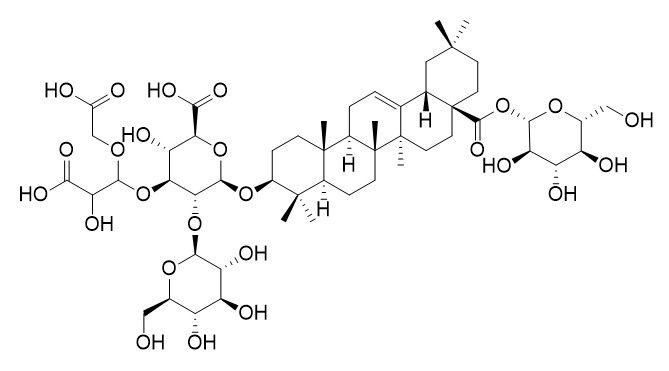Achyranthoside D
Reference standards.
Inquire / Order:
manager@chemfaces.com
Technical Inquiries:
service@chemfaces.com
Tel:
+86-27-84237783
Fax:
+86-27-84254680
Address:
1 Building, No. 83, CheCheng Rd., Wuhan Economic and Technological Development Zone, Wuhan, Hubei 430056, PRC
Providing storage is as stated on the product vial and the vial is kept tightly sealed, the product can be stored for up to
24 months(2-8C).
Wherever possible, you should prepare and use solutions on the same day. However, if you need to make up stock solutions in advance, we recommend that you store the solution as aliquots in tightly sealed vials at -20C. Generally, these will be useable for up to two weeks. Before use, and prior to opening the vial we recommend that you allow your product to equilibrate to room temperature for at least 1 hour.
Need more advice on solubility, usage and handling? Please email to: service@chemfaces.com
The packaging of the product may have turned upside down during transportation, resulting in the natural compounds adhering to the neck or cap of the vial. take the vial out of its packaging and gently shake to let the compounds fall to the bottom of the vial. for liquid products, centrifuge at 200-500 RPM to gather the liquid at the bottom of the vial. try to avoid loss or contamination during handling.
J Inflamm Res.2022, 15:5347-5359.
Food Sci Biotechnol.2021, 30(2):217-226.
J Microbiol Biotechnol.2023, 33(10):1317-1328.
Int J Mol Sci.2024, 25(16):8846.
Antioxidants (Basel).2023, 12(5):1111.
Nutrients.2017, 10(1)
Bioinformatics 2024, 586957
Aquaculture2017, 481:94-102
Phytomedicine.2018, 38:12-23
Integr Med Res.2021, 10(3):100723.
Related and Featured Products
Chinese Journal of Natural Medicines, 2012,10(2):98-101.
Triterpenoid saponins in roots of Achyranthese bidentata.[Reference:
WebLink]
To study the constituents in the roots of Achyranthese bidentata Bl.
METHODS AND RESULTS:
D-101 porous polymer resin column, normal-phase silica gel column chromatography, revised-phase medium pressure column chromatography, Sephadex LH-20 and prep-HPLC were used for the separation, and spectroscopic techniques were employed for the identification of the isolated compounds.
Five saponins were isolated and elucidated as achyranthoside C (1), Achyranthoside D (2), chikusetsusaponin IV (3), ginsenoside Ro (4) and zingibroside R1 (5).
CONCLUSIONS:
Compound 1 was obtained from natural source for the first time, and compound 3 was reported from the family of Amaranthaceae for the first time.



